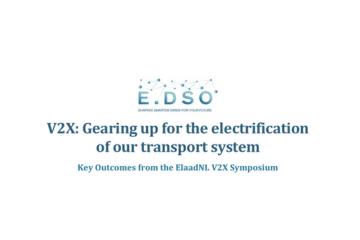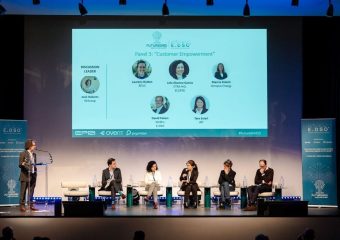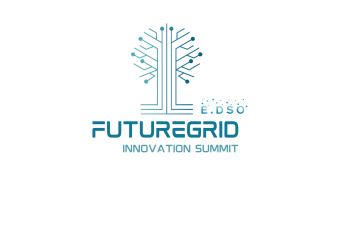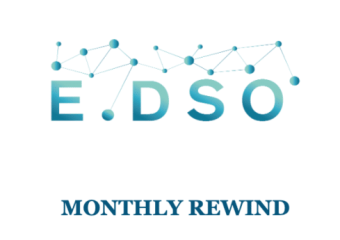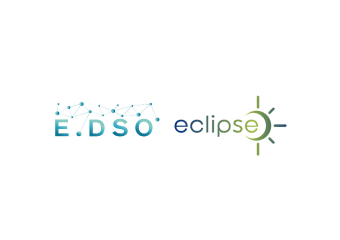Key Outcomes from the ElaadNL V2X Symposium
On 29 May, E.DSO took part in the Vehicle-to-Everything (V2X) Symposium organised by ElaadNL, the knowledge and innovation centre set up by the joint Dutch Grid Operators to research and test smart and sustainable charging of electric vehicles (EVs). For the occasion, the ElaadNL Testlab in Arnhem opened its doors for a day of insightful discussions aiming to answer one fundamental question for the future of electromobility: How can EV batteries power a sustainable energy system? Here are our key takeaways.
Vehicle-to-grid (V2G) and V2X respectively represent the concept of an EV storing energy and returning it to the power network or other energy-consuming destination, such as private homes or neighbourhoods. In 2023, the first edition of the ElaadNL Symposium already substantiated the enormous potential of V2X in terms of energy system integration. As remarked in the opening note by Baerte de Brey, Chief International Officer at ElaadNL, this second edition aimed to seize the V2X momentum, marking the right time to move from conception to implementation.
The event was kicked off with the findings from the recent report Unlocking EV Smart Charging to reduce grid congestion – lessons from the Netherlands by PricewaterhouseCoopers. As the electrification of demand and integration of intermittent Renewable Energy Sources (RES) raise increasing concerns about low voltage (LV) grid congestion, the report investigated how EVs can be harnessed to mitigate their own strain on the power system. While optimised smart charging, including V2G capabilities, could reduce required transformer capacity and associated grid investments, several institutional barriers still inhibit this potential. Well-designed pricing mechanisms and taxation, reliable approaches to load control and common data-sharing standards were identified as the missing elements towards the integrated power and transport system. Cooperation among distribution system operators (DSOs), European institutions, national regulatory authorities and governments will now be the key to optimal integration.
On their side, in this rapidly evolving ecosystem, DSOs face mounting challenges to connect new charging infrastructure as part of the decarbonisation and decentralisation of their network. Yet, they are gearing up to meet the targets set by the Alternative Fuels Infrastructure Regulation (AFIR) and take advantage of the opportunities offered by V2G technology. As outlined by Jan Kůla, leader of the “E-mobility” Task Force of E.DSO and Business Development Expert at ČEZ Distribuce, the evolution of e-mobility will be interlaced with all dimensions of distribution grid operation. Several milestones are to be reached on the way from non-controlled to grid-friendly charging: from enabling EV flexibility procurement for DSOs in support of grid planning to putting in place control systems capable of ensuring grid stability and emergency response. Increasing customer awareness and interaction, starting from the registration of new domestic charging stations, will also play a central role in the optimisation of load management. On the other hand, it is fundamental that connection requirements for V2G are updated in line with the latest technological developments, as emphasised by Florentien Benedict from Stedin and leader of the Expert Group Existing Network Codes in the EU DSO Entity. The ongoing amendment of Network Codes Requirements for Generators (NC RfG) and Demand Connection (NC DC) will introduce harmonised definitions and requirements to embrace the evolving role of e-mobility and storage in the power system.
On the other hand, streamlining connection processes, permitting and charging infrastructure planning also calls for a close collaboration between industry and public authorities. The experience of We Drive Solar and the Municipality of Utrecht, fueled by the ambition of becoming the first bidirectional city in Europe, proved how leveraging V2G technology can help overcome grid capacity bottlenecks, especially where the reinforcement of secondary substations is not a viable option in the short term.
Zooming further on LV infrastructure, currently installed cables and transformers will only be able to cope with 20% to 60% fleet electrification in case of uncontrolled charging. As demonstrated by a joint study of Enexis and ZEnMo, aiming for full transport electrification will require charging flexibility. Whereas smart charging alone could be theoretically sufficient to meet this objective, it would be necessary to control the charging session of over 90% of the total EVs to avoid congestion. Conversely, only 20% of EVs equipped with V2G technology would be required to achieve the same benefits. However, we should not let this promising opportunity catch us off guard. Without proper regulation in place, the simultaneous entry of V2G players into energy markets could cause a massive backlash in terms of grid congestion. The introduction of adequate congestion price incentives and balancing mechanisms should be assessed to counteract detrimental market behaviour, preventing electricity networks from paying the toll of an unregulated V2G market.
Gathering representatives from the power and automotive sectors, as well as local authorities from across Europe, the outcomes of the V2X Symposium underscored the crucial role of electromobility in the future energy system of tomorrow. While the untapped potential of bidirectional charging was undoubted, the event recognised the complexity of the challenges on the way to an efficient V2X market and the importance of preparing to address them. The electrification of transport and smart mobility are one of the priorities for the Hungarian presidency of the Council of the EU (July to December 2024) and also integral to the EU Strategic Agenda 2024-2029.
E.DSO gathers 36 leading electricity DSOs cooperating to ensure the reliability of electricity supply in Europe and the active participation of consumers in our energy system in line with the ambitious European climate and energy targets. E.DSO and its members are committed to supporting the optimal integration of the mobility and power sectors through knowledge sharing and cooperation, with two dedicated expert groups focusing on the regulatory and technical dimensions, respectively. Through its participation in the European-funded project FLOW, E.DSO is contributing to the development of a user-centric e-mobility concept that benefits distribution networks across Europe.

